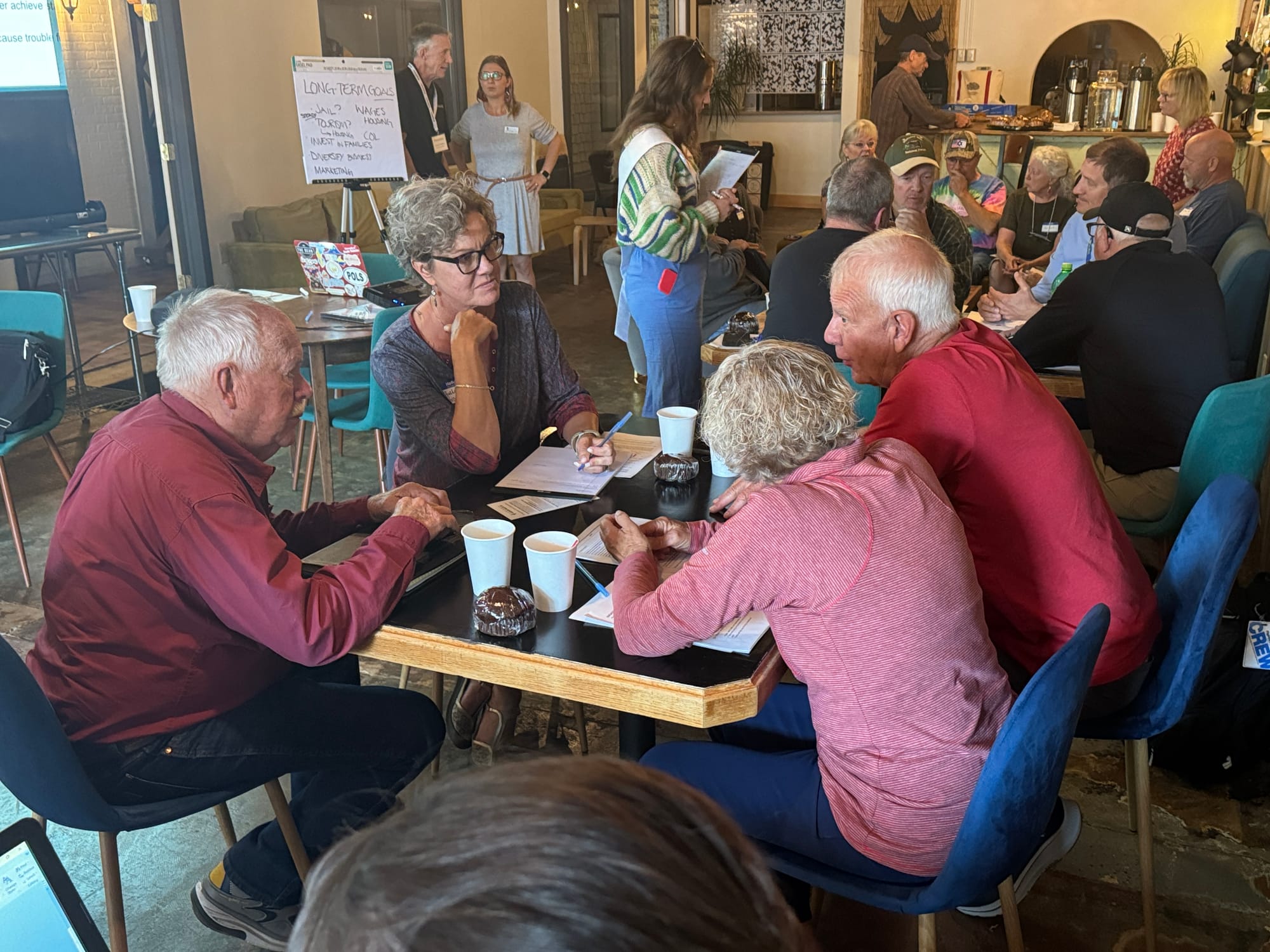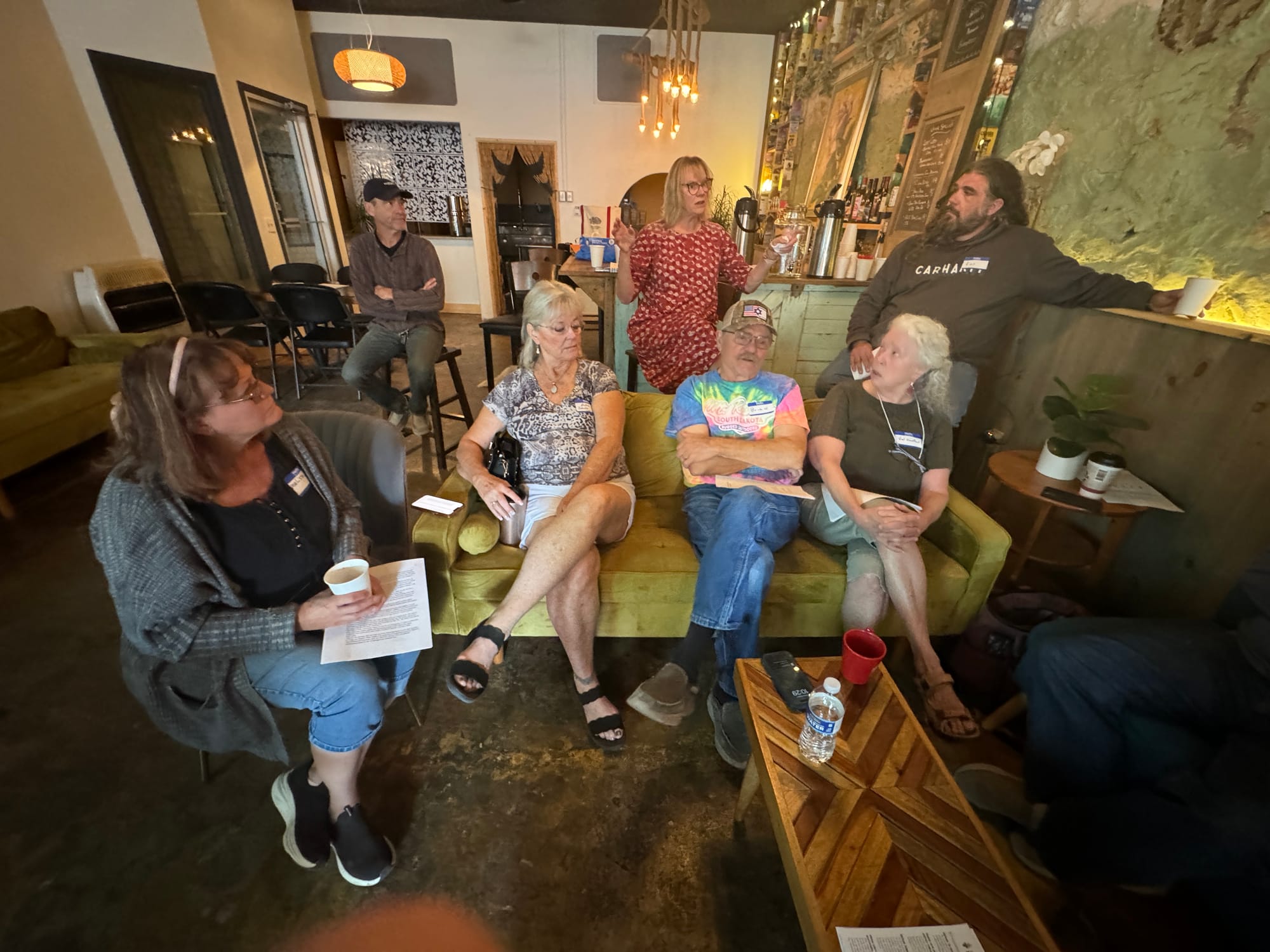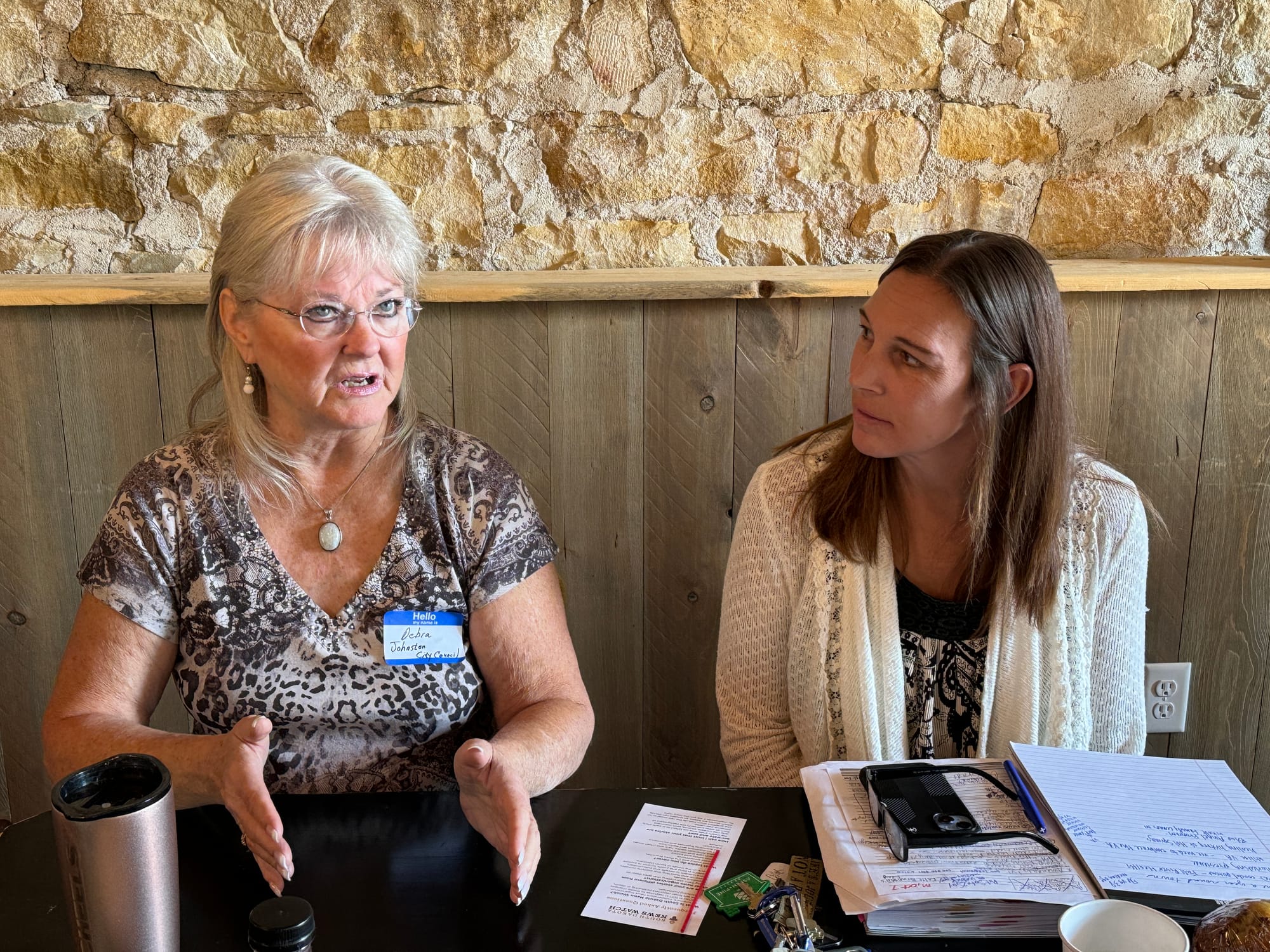
Bart Pfankuch / South Dakota News Watch
HOT SPRINGS, S.D. – A sense of optimism and opportunity filled the air as a group of residents of this southern Black Hills city gathered recently to forge a new potential path forward for their community.
The roughly two dozen people brought a wide variety of backgrounds: city council member, hospital administrator, school superintendent, landlord, artist.
Despite their inherent differences, they all shared one critical similarity: They were and remain committed to finding ways to make life better now and into the future in their beloved hometown of Hot Springs.
Challenges were quickly identified.
Housing availability and affordability. A lack of workers. A need for higher-wage jobs. Indecisiveness in how to move forward.
And then the ideas spilled forth, fast and diverse, both big picture and pinpoint.
Can public-private partnerships attract employers and development of new housing stock? Could Hot Springs repurpose its aging Veterans Affairs hospital into a university satellite campus? Would improved marketing of natural assets drive tourism, especially among young people? Could an enhanced riverwalk use exercise stations or a series of murals to lure more people downtown?
As suggestions flowed freely, no voice went unheard, and contrasting views were celebrated rather than diminished.
That approach is a key component of a new community betterment pilot program called Engage South Dakota, which is being administered jointly by South Dakota News Watch and the Chiesman Center for Democracy at the University of South Dakota.
Engage South Dakota uses community input, a citywide survey and meetings like the one held at The Space in Hot Springs in October to identify challenges and bring forward potentially replicable solutions. Findings will appear in a final report (available at the end of this story) and in news articles.
The ultimate goal is to inform the community and its leaders on public opinion, identify local challenges, and bring forth potential solutions that can spread to other towns dealing with some of the same issues.
A first step in strategic planning
Engage South Dakota adds a statewide storytelling element to a successful model of community-based strategic planning used in numerous other places, including across the state in Watertown.
In 2012, Watertown used responses to a community survey and other sources of resident input to drive a decade-long planning process that resulted in the development of a wellness center and ice arena and renovation of the local opera house. The city recently embarked on a second community planning effort using many of those same concepts with expectations of further growth based on the needs and wants of local residents.
The strength of those efforts, and of those intended by Engage South Dakota, is to obtain substantial resident input to guide decisions and actions of local elected and appointed officials, said Julia Hellwege, director of the Chiesman center and a co-leader of the Engage South Dakota program.
“This is a set of bottom-up recommendations, a clear idea of what the community members themselves recommend,” she said.

In Hot Springs, more than 300 of the city’s 3,600 residents completed the in-depth survey, which Hellwege said created “highly reliable survey data.” Based on the surveys and input from the October community meeting, Hellwege’s team generated a 43-page final report summarizing the findings and making recommendations for possible action.
Hellwege said the hope is that Hot Springs residents will use the report as a “lobbying document” to encourage city leaders to take the next step of engaging in a more formal strategic planning process.
“It’s one step toward the real strategic planning that is necessary,” she said. “This is a document that interested and invested community leaders can use to invest in a broader, more comprehensive plan because that’s what helps a community move forward, having a singular voice and knowing what the focus, priorities and goals should be.”
Encouraging community conversations
Carson Walker, CEO of News Watch and co-leader of Engage South Dakota, said the strong survey response rate and vibrant conversation at the community meeting show there is a desire and a need for greater resident input in the evolution of cities across the state.
“The information from the survey and the in-person meeting was phenomenal and really shows the value of dialogue,” Walker said.
The hope is that the positive reaction from residents and officials in Hot Springs will form the basis for expansion of Engage South Dakota planning efforts in other cities.
“The goal of this is to go to different places and address different topics, but then tie all the pieces together to address issues but also raise up potential solutions,” he said.
Walker said he also sees Engage South Dakota as a way to “equalize” the planning opportunities between urban areas that have the population and spending power to do extensive, formalized planning and within smaller, more rural communities that often do not have the resources to engage in long-range planning. Many small, rural communities in South Dakota are suffering from ongoing losses of population and economic activity, he said.

“What we’re doing is creating a blueprint for small communities to do this themselves,” he said. “A lot of communities in South Dakota are coming to grips with the fact that they’re 10 years away from vacant homes and other problems that come with losing population.”
The role of News Watch in the process, Walker said, is to help facilitate community input and get important conversations started in communities that want to grow and prosper. But moreover, News Watch can then bring those important stories and potentially replicable solutions to a statewide audience as a way to propagate similar planning efforts in other cities and towns.
“We’re really on the front edge of something that can jumpstart this process for the 300 communities across South Dakota,” he said.
Watertown preparing a new strategic plan
On Nov. 14, some good news arrived for those in Watertown who are trying to alleviate the city’s substantial shortage of day care spots that are needed to allow more parents to work.
The Governor’s Office of Economic Development announced that it was providing a $500,000 South Dakota Works Loan to the Mother of God Monastery in Watertown, where an effort is afoot to convert a building on the monastery campus into a day care center that could house up to 225 children.
In response to a local needs assessment, city and school officials in Watertown are also working together to convert shuttered elementary schools into day care centers.
Watertown leaders expect their next community survey report will be released soon, providing the next step in their ongoing planning journey.
Walker said sharing those solutions to the child care problem with a statewide audience will hopefully prompt similar ideas elsewhere.
Hot Springs survey reveals community needs
The online survey completed by Hot Springs residents revealed that the city faces many of the same major issues as other South Dakota cities, notably challenges in housing and workforce.
A majority of respondents listed housing (70%), business development (55%), workforce development (54%) and the labor shortage (52%) as major concerns.
Responses showed that residents feel they have the ability to make a difference in their community, but they are less certain of how decisions are made and are somewhat dissatisfied with the performance of local government.
Residents feel safe in their community and are happy with law enforcement, the survey showed.
But the survey also showed that some residents believe opportunities for greater growth and development are being missed, and concerns arose over the city’s positioning for long-term economic stability.
“Community leaders and regular citizens both understand the gravity of the home shortage, price and property tax issues, and largely understand why these issues have occurred. Creating affordable child care opportunities, ensuring the VA hospital remains operational, and capitalizing on the natural beauty of the area and the Sturgis Motorcycle Rally were other major discussion points,” the survey noted.

Andrea Powers, executive director of the Southern Hills Development Corp., said she was pleased to see the generally positive attitude in the survey responses and is optimistic that the community can use the process to bring forth positive change.
“There was an overall perception that our community has the capacity for economic growth and an increased quality of life without sacrificing the elegant Victorian character our town is renowned for,” she said.
Powers, whose organization has helped support the Engage South Dakota pilot program in Hot Springs, said the residents appear to support “metered growth,” in which future development occurs but does not change the overall sense of place, natural offerings and positive attitude now present in the community.
“In a rural community, people know and care for one another, pitch in where help is needed and hold a deep respect for the natural world, and these are all values the community wants to retain,” Powers said. “Sometimes that creates hesitancy about growth, but the overall consensus is that we can have positive change and retain our character if it’s done strategically.”
Community discussion mirrors survey results
About 25 residents showed up to the two-hour community discussion held at The Space in downtown Hot Springs, and a lively, communal vibe permeated the discussion.
Kyley Cumbow, superintendent of schools, moved to the area this summer to begin work in the fall semester. While planning her move from Pierre, Cumbow said she checked the website Zillow daily starting in April to see if any suitable housing was available in Hot Springs but with limited success. “I was in tears several times,” she said.
Cumbow, whose husband still works and lives in Pierre, said she considered buying a camper to live in until she found a house in Hot Springs. She said she bought a “fixer-upper” on the culmination of a dead-end street and started by remodeling a bathroom but has a long way to go in making the house more livable.

Attendees said one reason people might leave Hot Springs is because taxes and the cost of living are relatively high, while wages remain low.
Some brought up the challenges of having a population that is much older than the state median age and that there is a lack of racial, ethnic and age diversity in the local population. At the same time, some survey respondents said Hot Springs should embrace its role as a retirement community and make life better for senior citizen residents.
Resident Carl Hall said Hot Springs growth is held back by the lack of housing, especially affordable housing, and generally low wages. “People need to be able to make a living wage,” he said.
Hall added that the lack of housing opportunities puts potential homebuyers or renters at the mercy of property owners who sometimes have a strict screening process.
“You used to be able to quickly rent an apartment with cash and a handshake,” he said. “Now, it’s credit checks, background checks, questions about how much you make, and everything is done through contracts.”
City council member Debra Johnson said some people, including elderly residents, can no longer afford to live in Hot Springs.

“People are being priced out of their homes,” she said. “We don’t want the locals being pushed out of their homes and only the tourists or rich people being able to afford to live here.”
The city also has not done enough marketing of its assets, and the city for years was left off tourism maps that market the Black Hills to tourists, Johnson said.
Val Crawford, a property owner and landlord, said rents she charges have doubled in the past 20 years.
The city needs an influx of young people, and their spending power, so the city doesn’t eventually become a “dead building, people-waiting-to-die kind of place,” she said.
One resident said the city also needs a long-term plan with specific goals in order to grow in a sensible way and that community beautification efforts need to continue.
Jesse Naze, financial officer for Fall River Health Services, said the city should have more young people and a more diverse population to appeal to potential new residents and workers.
Naze said he has noticed a lower number of children engaging in sports, which he attributed to a lower birth rate exacerbated by an aging population.

The housing shortage and high costs of housing are holding back growth in the city, he said. Naze said the hospital has lost several prospective medical workers because they couldn’t find or afford suitable housing. He said he has also seen the number of hospital workers who commute from Rapid City rising in recent years.
Naze said Hot Springs has a committed group of people engaged in civic affairs but that “it does seem like the same people volunteering all the time.”
Potential solutions
Longtime resident Kelly Cape said that while the city has a significant number of income-subsidized houses and apartments, he hopes that more higher-end, market-priced housing units can be built to attract new residents and workers.
Cape also hoped the city could attract or target for relocation a wider range of employers, both large and small. He noted how Ellendale, north of Aberdeen, was able to land a new cyber-security firm that is expected to create between 50 and 100 new jobs.
Some other ideas:
- Resident Gary Telkamp said one of Hot Springs’ virtues is its nice weather, both compared to the Great Plains and other parts of South Dakota, and he suggested more marketing could focus on the dry and warm conditions. “That’s kind of a big deal and people need to know that about us.”
- Gail Sprentall floated an idea that the South Dakota Board of Regents could make an arrangement with the federal government to use part of the VA hospital complex into a satellite campus of the university system. The facility could have a natural resources educational focus, she said.
- Sprentall added that Hot Springs should “embrace” its VA connections and opportunities. She added that the community could better market its strong waterways, including Fall River, Angostura Reservoir, and other nearby lakes and campgrounds.
- Barb Hallberg, who hails from the Black Hills town of Nemo, said Hot Springs could emphasize its historic and current focus as a “center of healing.” “That could make Hot Springs more of a destination, and I don’t think we capitalize on that opportunity enough,” she said.
- One resident suggested the city could do more to market the many murals around town and create a walking tour that describes the murals and the artists. Someone suggested murals could be painted on the concrete retaining wall used for flood control.
- Councilor Johnson said the city already invested $3 million to have an elevated walkway along the river in the north part of downtown and another $40,000 to clean up weeds and other debris along the river corridor.
- Sandra Merrow, a counselor in Hot Springs, said she thinks that for an investment of roughly $15,000 the city could build a fitness course along the riverwalk that people could use to get a good workout while enjoying the downtown scenery. “It would be nice to have because people already walk along the river every day,” she said. “It would be great for locals and tourists to put up fitness stations along the way.”
Next steps
Powers, from the Hot Springs economic development group, said she will make sure the final Hot Springs report is provided to local elected officials and community leaders for review and to create new avenues for further discussion.
Cammie Mengwasser, executive director of the Watertown Area Community Foundation said earlier that the new planning group has initially identified three big challenges to address – housing, child care and workforce – but she expects the process will identify three or more other topics of focus moving forward.
Mengwasser said the next steps in the planning process will include a rollout of the consultant findings at a large community meeting early next year. “And that’s when the work will really start,” she said.
From there, resident committees will form to explore and examine issues revealed in the report, and local groups will then take their suggestions and do the ground-level work to get things done, she said.
“They’ll take the ideas, start researching them and then try to find funding to move toward what can ultimately come out of this,” she said.
